Amundsen–Scott South Pole Station
The Amundsen–Scott South Pole Station is a United States scientific research station at the South Pole, the southernmost place on the Earth. The station is located on the high plateau of Antarctica at an elevation of 2,835 metres (9,301 feet) above sea level and is administered by the Division of Polar Programs within the National Science Foundation under the United States Antarctic Program (USAP). It is named in honor of Norwegian Roald Amundsen and Englishman Robert F. Scott, who led separate teams that raced to become the first to the South Pole in the early 1900s.
Amundsen–Scott Station | |
|---|---|
| Amundsen–Scott South Pole Station | |
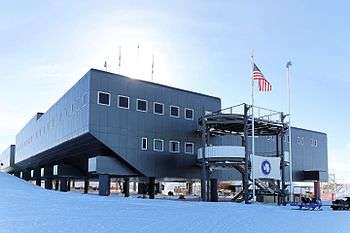 The Amundsen–Scott Station in 2009. In the foreground is Destination Alpha, one of the two main entrances. | |
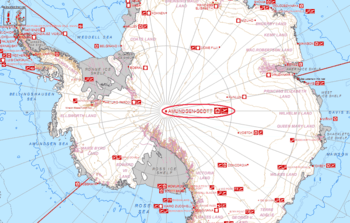 A map of Antarctica showing the location of the Amundsen–Scott South Pole Station (circled) | |
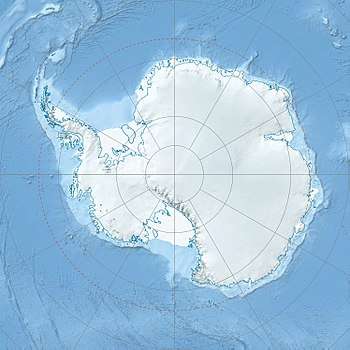 Amundsen–Scott Station Location of Amundsen–Scott Station at the South Pole in Antarctica | |
| Coordinates: 89°59′51.19″S 139°16′22.41″E | |
| Country | |
| Location in Antarctica | Geographic South Pole, Antarctic Plateau |
| Administered by | United States Antarctic Program by the National Science Foundation |
| Established | November 1956 |
| Named for | Roald Amundsen and Robert F. Scott |
| Elevation | 2,835 m (9,301 ft) |
| Population | |
| • Total |
|
| Time zone | UTC+12 (NZST) |
| • Summer (DST) | UTC+13 (NZDT) |
| Type | All year-round |
| Period | Annual |
| Status | Operational |
| Facilities | Facilities include:[1]
|
| Website | Amundsen-Scott South Pole Station |
The original Amundsen–Scott Station was built by Navy Seabees for the Federal government of the United States during November 1956, as a part of its commitment to the scientific goals of the International Geophysical Year (IGY), an international effort lasting from January 1957 through June 1958, to study, among other things, the geophysics of the polar regions of Earth.
Before November 1956, there was no permanent human structure at the South Pole, and practically no human presence in the interior of Antarctica at all. The few scientific stations in Antarctica were located near its seacoast. The station has been continuously occupied since it was built and has been rebuilt, demolished, expanded, and upgraded several times since 1956.
Since the Amundsen–Scott Station is located at the South Pole, it is at the only inhabited place on the land surface of the Earth from which the Sun is continuously visible for six months and is then continuously dark for the next six months. Thus, during each year, this station experiences one extremely long "day" and one equally long "night". During the six-month "day", the angle of elevation of the Sun above the horizon varies continuously. The Sun rises on the September equinox, reaches its maximum angle above the horizon on the southern summer solstice, and sets on the March equinox.
During this six-month "night", air temperatures can drop below −73 °C (−99 °F). This is also the time of the year when blizzards, often with gale-force winds, strike the Amundsen–Scott Station. Despite these blizzards, the continuous period of darkness and dry atmosphere make the station an excellent place from which to make astronomical observations.
The number of scientific researchers and members of the support staff housed at the Amundsen–Scott Station has always varied seasonally, with a peak population of around 200 in the summer operational season from October to February. In recent years the winter-time population has been around 50 people.
Structures
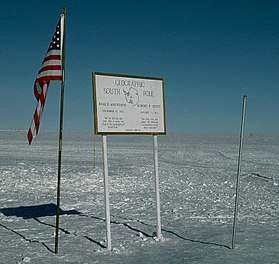
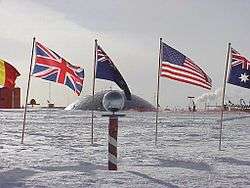
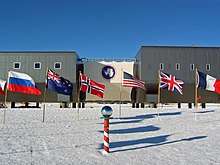
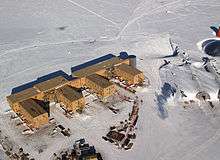
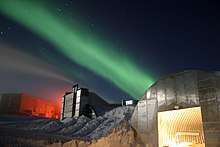
Original station (1957–1975)
The original South Pole station is now referred to as "Old Pole".
The station was constructed by U.S Navy Seabees led by LTJG Richard Bowers, the 8-man Advance Party being transported by the VX-6 Air Squadron in 2 R4Ds on 20 Nov. 1956. The U.S. Eighteenth Air Force's C-124 Globemaster IIs airdropped most of the equipment and building material. The buildings were constructed from prefabricated 4x8 foot modular panels. Exterior surfaces were four inches thick, with an aluminum interior surface, and a plywood exterior surface, sandwiching fiberglass. Skylights were the only windows in flat uniform roof levels, while buildings were connected by a burlap and chicken wire covered tunnel system. The last of the construction crew departed on 4 Jan. 1957. The first wintering-over party consisted of 8 IGY scientists led by Paul Siple and 8 Navy support men led by LTJG John Tuck. Key components of the camp included an astronomical observatory, a Rawin Tower, weather balloon inflation shelter, and a 1000-foot snow tunnel with pits for a seismometer and magnetometer. The lowest average temperatures recorded by the group were in the -90s F., though as Siple points out, "even at -60° I had seen men spitting blood because the capillaries of the bronchial tract frosted."[2]
On January 3, 1958, Sir Edmund Hillary's team from New Zealand, part of the Commonwealth Trans-Antarctic Expedition, reached the station over land from Scott Base, followed shortly by Sir Vivian Fuchs' British scientific component.[3]
The buildings of Old Pole were assembled from prefabricated components delivered to the South Pole by air and airdropped. They were originally built on the surface, with covered wood-framed walkways connecting the buildings. Although snow accumulation in open areas at the South Pole is approximately 8 in (20 cm) per year, wind-blown snow accumulates much more quickly in the vicinity of raised structures. By 1960, three years after the construction of the station, it had already been buried by 6 ft (1.8 m) of snow.[4]
The station was abandoned in 1975 and became deeply buried, with the pressure causing the mostly wooden roof to cave in. The station was demolished in December 2010, after an equipment operator fell through the structure doing snow stability testing for the National Science Foundation (NSF).[5][6] The area was being vetted for use as a campground for NGO guests.
Dome (1975–2003)
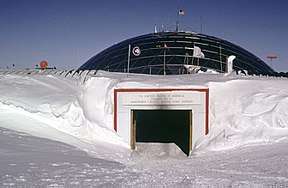
The station was moved in 1975 to the newly constructed Buckminster Fuller geodesic dome 50 meters (160 feet) wide by 16 meters (52 feet) high, with 14 m × 24 m (46 ft × 79 ft) steel archways. One served as the entry to the dome and it had a transverse arch that contained modular buildings for the station's maintenance, fuel bladders, power plant, snow melter, equipment and vehicles. Individual buildings within the dome contained the dorms, galley, rec, post office and labs for monitoring the upper and lower atmosphere and numerous other complex projects in astronomy and astrophysics. The station also included the Skylab, a box-shaped tower slightly taller than the dome. Skylab was connected to the Dome by a tunnel. The Skylab housed atmospheric sensor equipment and later a music room.
During the 1970–1974 summers, the Seabees constructing the dome were housed in Korean War era Jamesway huts. A hut consists of a wooden frame with a raised platform covered by canvas tarp. A double-doored vestibule was at each end. Although heated, the heat was not sufficient to keep them habitable during the winter. After several burned during the 1976–1977 summer, the construction camp was abandoned and later removed.
However, in the 1981–1982 season, extra civilian seasonal personnel were housed in a group of Jamesways known as the "summer camp". Initially consisting of only two huts, the camp grew to 11 huts housing about 10 people each, plus two recreational huts with bathroom and gym facilities. In addition, a number of science and berthing structures, such as the hypertats and elevated dormitory, were added in the 1990s, particularly for astronomy and astrophysics.
During the period in which the dome served as the main station, many changes to United States South Pole operation took place. From the 1990s on, astrophysical research conducted at the South Pole took advantage of its favorable atmospheric conditions and began to produce important scientific results. Such experiments include the Python, Viper, and DASI telescopes, as well as the 10 m (390 in) South Pole Telescope. The DASI telescope has since been decommissioned and its mount used for the Keck Array.[7] The AMANDA / IceCube experiment makes use of the two-mile (3 km)-thick ice sheet to detect neutrinos which have passed through the earth. An observatory building, the Martin A. Pomerantz Observatory (MAPO), was dedicated in 1995. The importance of these projects changed the priorities in station operation, increasing the status of scientific cargo and personnel.
The 1998–1999 summer season was the last year that VXE-6 with its Lockheed LC-130s serviced the U.S. Antarctic Program. Beginning in 1999–2000, the New York Air National Guard 109th Airlift Wing took responsibility for the daily cargo and passenger flights between McMurdo Station and the South Pole during the summer.
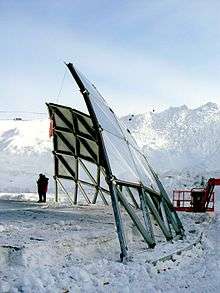
During the winter of 1988 a loud crack was heard in the dome. Upon investigation it was discovered that the foundation base ring beams were broken due to being overstressed.[8]
The dome was dismantled in late 2009.[9] It was crated and given to the Seabees. They have it in storage at Port Hueneme, California. The center oculus is suspended in a display at the Seabee Museum there.
Elevated station (2003–present)

In 1992, the design of a new station began for a 7,400 m2 (80,000 sq ft) building with two floor levels that cost US$150 million.[10] Construction began in 1999, adjacent to the Dome. The facility was officially dedicated on January 12, 2008 with a ceremony that included the de-commissioning of the old Dome station.[11] The ceremony was attended by a number of dignitaries flown in specifically for the day, including National Science Foundation Director Arden Bement, scientist Susan Solomon and other government officials. The entirety of building materials to complete the build of the new South Pole Station were flown in from McMurdo Station by the LC-130 Hercules aircraft and the 139th Airlift Squadron Stratton Air National Guard Base, Scotia New York.
The new station included a modular design, to accommodate an increasing station population, and an adjustable elevation, in order to prevent the station from being buried in snow. In a location where about 20 centimetres (8 in) of snow accumulates every year without ever thawing,[12][13] the building's rounded corners and edges help reduce snow drifts. The building faces into the wind with a sloping lower portion of wall. The angled wall increases the wind speed as it flows under the buildings, and passes above the snow-pack, causing the snow to be scoured away. This prevents the building from being quickly buried. Wind tunnel tests show that scouring will continue to occur until the snow level reaches the second floor.
Because snow gradually settles over time under its own weight, the foundations of the building were designed to accommodate substantial differential settling over any one wing in any one line or any one column. If differential settling continues, the supported structure will need to be jacked up and re-leveled. The facility was designed with the primary support columns outboard of the exterior walls so that the entire building can be jacked up a full floor level. During this process, a new section of column will be added over the existing columns then the jacks pull the building up to the higher elevation.
Operation
During the summer the station population is typically around 150. Most personnel leave by the middle of February, leaving a few dozen (42 in 2020) "winter-overs", mostly support staff plus a few scientists, who keep the station functional through the months of Antarctic night. The winter personnel are isolated between mid-February and late October. Wintering-over presents notorious dangers and stresses, as the station population is almost totally isolated. The station is completely self-sufficient during the winter, and powered by three generators running on JP-8 jet fuel. An annual tradition is a back-to-back viewing of The Thing from Another World (1951), The Thing (1982), and The Thing (2011) after the last flight has left for the winter.[14]
Research at the station includes glaciology, geophysics, meteorology, upper atmosphere physics, astronomy, astrophysics, and biomedical studies. In recent years, most of the winter scientists have worked for the IceCube Neutrino Observatory or for low-frequency astronomy experiments such as the South Pole Telescope and BICEP2. The low temperature and low moisture content of the polar air, combined with the altitude of over 2,743 m (8,999 ft), causes the air to be far more transparent on some frequencies than is typical elsewhere, and the months of darkness permit sensitive equipment to run constantly.
There is a small greenhouse at the station. The variety of vegetables and herbs in the greenhouse, which range from fresh eggplant to jalapeños, are all produced hydroponically, using only water and nutrients and no soil. The greenhouse is the only source of fresh fruit and vegetables during the winter.
Transportation
The station has a runway for aircraft (ICAO: NZSP), 3,658 m (12,001 ft) long. Between October and February, there are several flights per day of U.S. Air Force ski-equipped Lockheed LC-130 Hercules aircraft from the New York Air National Guard, 109 AW, 139AS Stratton Air National Guard via McMurdo Station to supply the station. Resupply missions are collectively termed Operation Deep Freeze.
There is a snow road over the ice sheet from McMurdo, the McMurdo-South Pole highway, which is 995 miles (1601 km) long.
Communication
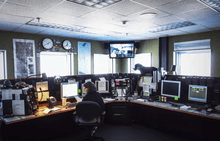
Data access to the station is provided by NASA's TDRS-4, 5, and 6 satellites, the DOD DSCS-3 satellite, and the commercial Iridium satellite constellation. For the 2007–2008 season, the TDRS relay (named South Pole TDRSS Relay or SPTR) was upgraded to support a data return rate of 50 Mbit/s, which comprises over 90% of the data return capability.[15][16] The TDRS-1 satellite formerly provided services to the station, but it failed in October 2009 and was subsequently decommissioned. Marisat and LES9 were also formerly used. In July 2016, the GOES-3 satellite was decommissioned due to it nearing the end of its supply of propellant and was replaced by the use of the DSCS-3 satellite, a military communications satellite. DSCS-3 can provide a 30 MB/s data rate compared to GOES-3's 1.5 MB/s. DSCS-3 and TDRS-4, 5, and 6 are used together to provide the main communications capability for the station. These satellites provide the data uplink for the station's scientific data as well as provide broadband internet and telecommunications access. Only during the main satellite events is the station's telephone system able to dial out. The commercial Iridium satellite is used when the TDRS and DSCS satellites are all out of range to give the station limited communications capability during those times. During those times, telephone calls may only be made on several Iridium satellite telephone sets owned by the station. The station's IT system also has a limited data uplink over the Iridium network, which allows emails less than 100 KB to be sent and received at all times and small critical data files to be transmitted. This uplink works by bonding the data stream over 12 voice channels.
Astrophysics experiments at the station
Cosmic Microwave Background Telescopes:
- Python Telescope (1992–1997),[17] used to observe temperature anisotropies in the cosmic microwave background (CMB).[18]
- Viper telescope (1997–2000), used to observe temperature anisotropies in the CMB.[17] Was refitted with the ACBAR bolometer (2000-2008).[19]
- DASI (1999–2000), used to measure the temperature and power spectrum of the CMB.[20]
- The QUaD (2004–2009), used the DASI mount, used to make detailed observations of CMB polarization.[21][22]
- The BICEP1 (2006–2008) and BICEP2 (2010–2012) instruments were also used to observe polarization anisotropies in the CMB. BICEP3 was installed in 2015.[23]
- South Pole Telescope (2007–present), used to survey the CMB to look for distant galaxy clusters.[24]
- The Keck Array (2010–present), using the DASI mount,[7] is now used to continue work on the polarization anisotropies of the CMB.
Neutrino Experiments
- AMANDA (1997–2009) was an experiment to detect neutrinos.[25]
- IceCube (2010–present), is an experiment to detect neutrinos.[26]
- Radio Ice Cherenkov Experiment or RICE (1999–2012), an experiment to detect ultra high energy (UHE) neutrinos.
- Neutrino Array Radio Calibration or NARC (2008–2012), an upgrade of the RICE experiment.
- Askaryan Radio Array or ARA (2011–present), a successor of RICE, currently (as of 2019) under construction.
Climate
Typical of inland Antarctica, Amundsen–Scott South Pole Station experiences an ice cap climate (EF) with BWk precipitation patterns.[27] The peak season of summer lasts October to mid February.
| Climate data for Amundsen–Scott South Pole Station | |||||||||||||
|---|---|---|---|---|---|---|---|---|---|---|---|---|---|
| Month | Jan | Feb | Mar | Apr | May | Jun | Jul | Aug | Sep | Oct | Nov | Dec | Year |
| Record high °C (°F) | −14.4 (6.1) |
−20.6 (−5.1) |
−26.7 (−16.1) |
−27.8 (−18.0) |
−25.1 (−13.2) |
−28.8 (−19.8) |
−33.9 (−29.0) |
−32.8 (−27.0) |
−29.3 (−20.7) |
−25.1 (−13.2) |
−18.9 (−2.0) |
−12.3 (9.9) |
−12.3 (9.9) |
| Average high °C (°F) | −26.0 (−14.8) |
−37.9 (−36.2) |
−49.6 (−57.3) |
−53.0 (−63.4) |
−53.6 (−64.5) |
−54.5 (−66.1) |
−55.2 (−67.4) |
−54.9 (−66.8) |
−54.4 (−65.9) |
−48.4 (−55.1) |
−36.2 (−33.2) |
−26.3 (−15.3) |
−45.8 (−50.4) |
| Daily mean °C (°F) | −28.4 (−19.1) |
−40.9 (−41.6) |
−53.7 (−64.7) |
−57.8 (−72.0) |
−58.0 (−72.4) |
−58.9 (−74.0) |
−59.8 (−75.6) |
−59.7 (−75.5) |
−59.1 (−74.4) |
−51.6 (−60.9) |
−38.2 (−36.8) |
−28.0 (−18.4) |
−49.5 (−57.1) |
| Average low °C (°F) | −29.6 (−21.3) |
−43.1 (−45.6) |
−56.8 (−70.2) |
−60.9 (−77.6) |
−61.5 (−78.7) |
−62.8 (−81.0) |
−63.4 (−82.1) |
−63.2 (−81.8) |
−61.7 (−79.1) |
−54.3 (−65.7) |
−40.1 (−40.2) |
−29.1 (−20.4) |
−52.2 (−62.0) |
| Record low °C (°F) | −41.1 (−42.0) |
−58.9 (−74.0) |
−71.1 (−96.0) |
−75.0 (−103.0) |
−78.3 (−108.9) |
−82.8 (−117.0) |
−80.6 (−113.1) |
−79.3 (−110.7) |
−79.4 (−110.9) |
−72.0 (−97.6) |
−55.0 (−67.0) |
−41.1 (−42.0) |
−82.8 (−117.0) |
| Average precipitation mm (inches) | 0.3 (0.01) |
0.6 (0.02) |
0.2 (0.01) |
0.1 (0.00) |
0.2 (0.01) |
0.1 (0.00) |
0.0 (0.0) |
0.0 (0.0) |
0.1 (0.00) |
0.1 (0.00) |
0.1 (0.00) |
0.3 (0.01) |
2.3 (0.09) |
| Average snowfall cm (inches) | 0.3 (0.1) |
0.5 (0.2) |
— | — | 0.3 (0.1) |
— | trace | — | — | — | — | 0.3 (0.1) |
1.3 (0.5) |
| Average precipitation days (≥ 0.1 mm) | 0.2 | 0.3 | 0.2 | 0.0 | 0.2 | 0.1 | 0.0 | 0.0 | 0.1 | 0.1 | 0.1 | 0.3 | 1.6 |
| Average snowy days | 22.0 | 19.6 | 13.6 | 11.4 | 17.2 | 17.3 | 18.2 | 17.5 | 11.7 | 16.7 | 16.9 | 20.6 | 203.0 |
| Mean monthly sunshine hours | 406.1 | 497.2 | 195.3 | 0.0 | 0.0 | 0.0 | 0.0 | 0.0 | 34.1 | 390.6 | 558.0 | 616.9 | 2,698.2 |
| Mean daily sunshine hours | 13.1 | 17.6 | 6.3 | 0.0 | 0.0 | 0.0 | 0.0 | 0.0 | 1.1 | 12.6 | 18.6 | 19.9 | 7.4 |
| Source 1: Pogoda.ru.net (temperatures, 1981–2010, extremes 1957–present)[28] | |||||||||||||
| Source 2: Deutscher Wetterdienst (Precipitation 1957–1988 and Sun 1978–1993),[29] NOAA (snowy days and snowfall data, 1961–1988)[30] | |||||||||||||
Media and events
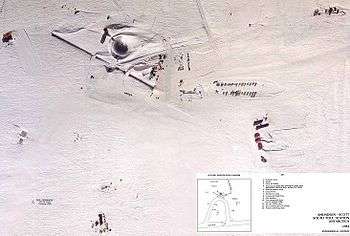
In 1991, Michael Palin visited the base on the 8th and final episode of his BBC Television documentary, Pole to Pole.[31][32]
On January 10, 1995, NASA, PBS, and NSF collaborated for the first live television broadcast from the South Pole, titled Spaceship South Pole.[33] During this interactive broadcast, students from several schools in the United States asked the scientists at the station questions about their work and conditions at the pole.[34]
In 1999, CBS News correspondent Jerry Bowen reported on camera in a talkback with anchors from the Saturday edition of CBS This Morning.
In 1999, the winter-over physician, Jerri Nielsen, found that she had breast cancer. She had to rely on self-administered chemotherapy, using supplies from a daring July cargo drop, then was picked up in an equally dangerous mid-October landing.
On May 11, 2000, astrophysicist Rodney Marks became ill while walking between the remote observatory and the base. He became increasingly sick over 36 hours, three times returning increasingly distressed to the station's doctor. Advice was sought by satellite, but Marks died on May 12, 2000 with his condition undiagnosed.[35][36] The National Science Foundation issued a statement that Rodney Marks had "apparently died of natural causes, but the specific cause of death had yet to be determined".[37] The exact cause of Marks' death could not be determined until his body was removed from Amundsen–Scott Station and flown off Antarctica for an autopsy.[38] Marks' death was due to methanol poisoning, and the case received media attention as the "first South Pole murder",[39] although there is no evidence that Marks died as the result of the act of another person.[40][41]
On 26 April 2001, Kenn Borek Air used a DHC-6 Twin Otter aircraft to rescue Dr. Ronald Shemenski from Amundsen–Scott.[42][43][44][45] This was the first ever rescue from the South Pole during polar winter.[46] To achieve the range necessary for this flight, the Twin Otter was equipped with a special ferry tank.
In January 2007, the station was visited by a group of high-level Russian officials, including FSB chiefs Nikolai Patrushev and Vladimir Pronichev. The expedition, led by polar explorer Artur Chilingarov, started from Chile on two Mi-8 helicopters and landed at the South Pole.[47][48]
On September 6, 2007, The National Geographic Channel's television show Man Made aired an episode on the construction of their new facility.[49]
On the November 9, 2007 edition of NBC's Today, show co-anchor Ann Curry made a satellite telephone call which was broadcast live from the South Pole.[50]
On Christmas 2007, two employees at the base got into a drunken fight and had to be evacuated.[51]
On July 11, 2011, the winter-over communications technician fell ill and was diagnosed with appendicitis. An emergency open appendectomy was performed by the station doctors with several winter-overs assisting during the surgery.
The 2011 BBC TV programme Frozen Planet discusses the base and shows footage of the inside and outside of the elevated station in the "Last Frontier Episode".
During the 2011 winter-over season, station manager Renee-Nicole Douceur experienced a stroke on August 27, resulting in loss of vision and cognitive function. Because the Amundsen–Scott base lacks diagnostic medical equipment such as an MRI or CT scan machine, station doctors were unable to fully evaluate the damage done by the stroke or the chance of recurrence. Physicians on site recommended a medevac flight as soon as possible for Douceur, but offsite doctors hired by Raytheon Polar Services (the company contracted to run the base) and the National Science Foundation disagreed with the severity of the situation. The National Science Foundation, which is the final authority on all flights and assumes all financial responsibility for the flights, denied the request for medevac, saying the weather was still too hazardous.[52] Plans were made to evacuate Douceur on the first flight available. Douceur and her niece, believing Douceur's condition to be grave and believing an earlier medevac flight possible, contacted Senator Jeanne Shaheen for assistance; as the NSF continued to state Douceur's condition did not qualify for a medevac attempt and conditions at the base would not permit an earlier flight, Douceur and her supporters brought the situation to media attention.[53][54] Douceur was evacuated, along with a doctor and an escort, on an October 17 cargo flight. This was the first flight available when the weather window opened up on October 16. This first flight is usually solely for supply and refueling of the station, and does not customarily accept passengers, as the plane's cabin is unpressurized.[55][56] The evacuation was successful, and Douceur arrived in Christchurch, New Zealand, at 10:55 p.m.[57] She ultimately made a full recovery.[58]
In March 2014, BICEP2 announced that they had detected B-modes from gravitational waves generated in the early universe, supporting the inflation theory of cosmology.[59] Later analysis showed that BICEP only saw polarized dust signal in the galaxy and not primordial B-modes.[60]
On 20 June 2016, there was another medical evacuation of two personnel around midwinter day, again involving Kenn Borek Air and DHC-6 Twin Otter aircraft.[61][62][63]
In December 2016, Buzz Aldrin was visiting the Amundsen–Scott South Pole Station, Antarctica, as part of a tourist group, when he fell ill and was evacuated, first to McMurdo Station and from there to Christchurch, New Zealand, where he was reported to be in stable condition. Aldrin's visit at age 86 makes him the oldest person to ever reach the South Pole.
In the summer of 2016–17, Anthony Bourdain filmed part of an episode of his television show Anthony Bourdain: Parts Unknown at the station.[64]
In popular culture
Science and life at the Amundsen-Scott South Pole station is documented in Dr. John Bird's award-winning book, One Day, One Night: Portraits of the South Pole[65][66][67][68] which chronicles the South Pole Foucault Pendulum,[69][70] the 300 Club,[68] the first midwinter medevac, and science at the Pole including climate change and cosmology.
Science fiction author Kim Stanley Robinson's book Antarctica features a fictionalized account of the culture at Amundsen–Scott and McMurdo, set in the near future.
The station is featured prominently in the 1998 The X-Files film Fight the Future.
The 2009 film Whiteout is mainly set at the Amundsen–Scott base, although the building layouts are completely different.
The turn-based strategy game Civilization VI, in its expansion Rise and Fall, included the Amundsen–Scott South Pole Station as a Wonder.
The anime OVA Mobile Suit Gundam: The Origin features a large city in Antarctica called Scott City under a Geodesic dome not unlike the 1975 dome as the location of a major peace conference between the human space colonies controlled by Zeon and the Earth Federation.
The 2019 film Where'd You Go, Bernadette features the station prominently and includes scenes of its construction at the closing credits, although the actual station depicted in the film is Halley VI British Antarctic Research Station.
Time zone
The South Pole sees the Sun rise and set only once a year. Due to atmospheric refraction, these do not occur exactly on the September equinox and the March equinox, respectively: the Sun is above the horizon for four days longer at each equinox. The place has no solar time; there is no daily maximum or minimum solar height above the horizon. The station uses New Zealand time (UTC+12 during standard time and UTC+13 during daylight saving time) since all flights to McMurdo station depart from Christchurch and, therefore, all official travel from the pole goes through New Zealand.
The zone identifier in the IANA time zone database is Antarctica/South Pole.
See also
- Concordia Station
- Kunlun Station
- List of Antarctic field camps
- List of Antarctic research stations
- Paul Siple
- Polheim, Amundsen's name for the first South Pole camp.
- Scott Base
- Vostok Station
References
- "Amundsen-Scott South Pole Station". Giosciences: Polar Programs. National Science Foundation. Retrieved July 11, 2016.
- Siple, Paul (1959). 90° South. New York: G.P. Putnam's Sons. pp. 158, 164, 168–169, 175–177, 192–193, 198, 239–240, 293, 303, 370–371.
- "Edmund Hillary in Antarctica". New Zealand History. New Zealand Ministry for Culture and Heritage. Retrieved March 31, 2016.
- Barna, Lynette; Courville, Zoe; Rand, John; Delaney, Allan (July 2015). Remediation of Old South Pole Station, Phase I: Ground-Penetrating-Radar Surveys. Hanover, NH: U.S. Army Engineer Research and Development Center. Retrieved May 3, 2016.
- "South Pole's first building blown up after 53 years". OurAmazingPlanet.com. March 31, 2011.
- South Pole's First Building Blown Up After 53 Years, livescience.com, 2011
- "Keck Array Overview". Harvard–Smithsonian Center for Astrophysics. National Science Foundation. Retrieved July 28, 2014.
- "News about Antarctica - Deconstruction of the Dome (page 2)". The Antarctic Sun. United States Antarctic Program. Retrieved August 3, 2017.
- "News about Antarctica - Deconstruction of the Dome (page 1)". The Antarctic Sun. United States Antarctic Program. Retrieved August 3, 2017.
- "FY 2008 NSF Budget Request to Congress" (PDF). National Science Foundation. Retrieved November 8, 2009.
- "A New Era". The Antarctic Sun. United States Antarctic Program. May 1, 2009. Retrieved May 1, 2009.
- "Sub-Zero Tech". Modern Marvels. Season 12. Episode 11. February 23, 2005. History Channel.
- "Initial Environmental Evaluation Development of Blue-Ice and Compacted-Snow Runways in support of the U.S. Antarctic Program". National Science Foundation Office of Polar Programs. April 9, 1993.
- McLane, Marie (March 8, 2013). "South Pole enters winter with crew of 44 people". The Antarctic Sun. United States Antarctic Program. Retrieved February 26, 2014.
- "South Pole - News". Amundsen-Scott South Pole Station. Retrieved November 8, 2009.
- Israel, D. J. (September 1, 2000). "South Pole TDRSS Relay (SPTR)". Astrophysics from Antarctica. 141: 319. Bibcode:1998ASPC..141..319I. Archived from the original on May 25, 2009. Retrieved November 8, 2009.
- "CARA Science: Overview". University of Chicago Department of Astronomy and Astrophysics. Retrieved August 4, 2014.
- Coble, K.; Dragovan, M.; Kovac, J.; Halverson, N. W.; Holzapfel, W. L.; Knox, L.; Dodelson, S.; Ganga, K.; Alvarez, D.; Peterson, J. B.; Griffin, G.; Newcomb, M.; Miller, K.; Platt, S.R.; Novak, G. (July 1, 1999). "Anisotropy in the Cosmic Microwave Background at Degree Angular Scales: Python V Results". The Astrophysical Journal. 519 (1): L5–L8. arXiv:astro-ph/9902195. Bibcode:1999ApJ...519L...5C. doi:10.1086/312093.
- "Arcminute Cosmology Bolometer Array Receiver: Instrument Description". Berkeley Cosmology Group. Retrieved August 4, 2014.
- Leitch, E.M.; et al. (December 2002). "Measurement of polarization with the Degree Angular Scale Interferometer". Nature. 420 (6917): 763–771. arXiv:astro-ph/0209476. Bibcode:2002Natur.420..763L. doi:10.1038/nature01271. PMID 12490940.
- Ade, P.; Bock, J.; Bowden, M.; Brown, M. L.; Cahill, G.; Carlstrom, J. E.; Castro, P. G.; Church, S.; Culverhouse, T.; Friedman, R.; Ganga, K.; Gear, W. K.; Hinderks, J.; Kovac, J.; Lange, A. E.; Leitch, E.; Melhuish, S. J.; Murphy, J. A.; Orlando, A.; Schwarz, R.; O'Sullivan, C.; Piccirillo, L.; Pryke, C.; Rajguru, N.; Rusholme, B.; Taylor, A. N.; Thompson, K. L.; Wu, E. Y. S.; Zemcov, M. (February 10, 2008). "First Season QUaD CMB Temperature and Polarization Power Spectra". The Astrophysical Journal. 674 (1): 22–28. arXiv:0705.2359. Bibcode:2008ApJ...674...22A. doi:10.1086/524922.
- Brown, M. L.; Ade, P.; Bock, J.; Bowden, M.; Cahill, G.; Castro, P. G.; Church, S.; Culverhouse, T.; Friedman, R. B.; Ganga, K.; Gear, W. K.; Gupta, S.; Hinderks, J.; Kovac, J.; Lange, A. E.; Leitch, E.; Melhuish, S. J.; Memari, Y.; Murphy, J. A.; Orlando, A.; Sullivan, C. O'; Piccirillo, L.; Pryke, C.; Rajguru, N.; Rusholme, B.; Schwarz, R.; Taylor, A. N.; Thompson, K. L.; Turner, A. H.; Wu, E. Y. S.; Zemcov, M. (November 1, 2009). "Improved Measurements of the Temperature and Polarization of the Cosmic Microwave Background From QUaD". The Astrophysical Journal. 705 (1): 978–999. arXiv:0906.1003. Bibcode:2009ApJ...705..978B. doi:10.1088/0004-637X/705/1/978.
- Francis, Matthew R. (May 16, 2016). "Dusting for the fingerprint of inflation with BICEP3". Symmetry. Fermilab/SLAC.
- Ruhl, John; et al. (October 2004). "The South Pole Telescope". In Zmuidzinas, Jonas; Holland, Wayne S; Withington, Stafford (eds.). Millimeter and Submillimeter Detectors for Astronomy II. Proc. SPIE. 5498. pp. 11–29. arXiv:astro-ph/0411122. doi:10.1117/12.552473.
- Mgrdichian, Laura. "Amanda's First Six Years". Phys.org. Retrieved August 4, 2014.
- "IceCube South Pole Neutrino Observatory". University of Wisconsin-Madison. Retrieved August 4, 2014.
- "South Pole, Antarctica". WeatherBase. Retrieved October 7, 2009.
- "Weather and Climate – The Climate of Amundsen–Scott". Weather and Climate (Погода и климат) (in Russian). Retrieved April 5, 2017.
- "Klimatafel von Amundsen-Scott / Südpol-Station (USA) / Antarktis" (PDF). Baseline climate means (1961–1990) from stations all over the world (in German). Deutscher Wetterdienst. Retrieved April 5, 2017.
- "Amundsen–Scott Climate Normals 1961−1990". National Oceanic and Atmospheric Administration. Retrieved April 5, 2017.
- Palin, Michael. "Day 141: To the South Pole". palinstravels.co.uk. Retrieved August 3, 2017.
- BBC Worldwide (September 20, 2007). "Michael Palin reaches the South Pole". YouTube. Retrieved August 3, 2017.
- "Live From Antarctica". Passport to Knowledge. Retrieved October 4, 2010.
- Falxa, Greg. "Tech Crew at the South Pole Interactive TV Broadcast". Falxa.net. Retrieved November 8, 2009.
- "In Memoriam". The CfA Almanac. Harvard-Smithsonian Center for Astrophysics. XIII (2). July 2000. Archived from the original on October 26, 2006. Retrieved December 19, 2006.
- "Memorial". Amundsen–Scott South Pole Station. Retrieved December 19, 2006.
- "Antarctic Researcher Dies" (Press release). Arlington, Virginia: National Science Foundation Office of Legislative and Public Affairs. May 12, 2000. Retrieved December 19, 2006.
- "Australian scientist dies during Pole winter". The Antarctic Sun. United States Antarctic Program. October 22, 2000. Archived from the original on February 18, 2007. Retrieved December 19, 2006.
- Chapman, Paul (December 14, 2006). "New Zealand Probes What May Be First South Pole Murder". The Daily Telegraph. Archived from the original on November 3, 2007. Retrieved December 19, 2006.
- "Death of Australian astrophysicist an Antarctic whodunnit". Deutsche Presse-Agentur. December 14, 2006. Archived from the original on September 1, 2007. Retrieved December 19, 2006.
- Cockrell, Will (December 2009). "A Mysterious Death at the South Pole". Men's Journal. Retrieved February 13, 2015.
- Weber, Bob (January 23, 2013). "Bad weather hampers search for 3 Canadians on plane missing in Antarctica". Global News. Archived from the original on February 19, 2013. Retrieved January 23, 2013.
- "Kenn Borek plane carrying three Canadians missing in Antarctica". CTV News Calgary. January 23, 2013. Retrieved January 23, 2013.
- Antol, Bob (April 2001). "The Rescue of Dr. Ron Shemenski from the South Pole". Bob Antol's Polar Journals. Retrieved January 23, 2013.
- "Doctor rescued from Antarctica safely in Chile". The New Zealand Herald. April 27, 2001. Retrieved January 23, 2013.
- "Plane With Dr. Shemenski Arrives in Chile". CNN. April 26, 2001. Retrieved January 23, 2013.
- "Patrushev lands at South Pole during Antarctic expedition". Interfax. Archived from the original on September 30, 2007.
- "Two Russian helicopters land at the South Pole". TimesRussia. January 9, 2007. Archived from the original on October 9, 2007. Retrieved November 8, 2009.
- "Man-Made: The South Pole Project". National Geographic Channel. Archived from the original on October 22, 2007.
- Celizic, Mike (November 9, 2007). "Today's world traveler ready to come back". Today.com. Retrieved November 8, 2009.
- McMahon, Barbara (December 27, 2007). "Antarctic base staff evacuated after Christmas brawl". The Guardian. London. Retrieved November 8, 2009.
- "Pilot describes Antarctica wx challenges". Weather.com. Archived from the original on October 18, 2011.
- Quenqua, Douglas (October 7, 2011). "Worker at South Pole Station Pushes for a Rescue After a Stroke". The New York Times. Retrieved October 14, 2011.
- Niiler, Eric (October 7, 2011). "Evacuation is denied for South Pole stroke victim". MSNBC. Archived from the original on October 8, 2011. Retrieved October 14, 2011.
- "Raytheon worker stuck in South Pole is coming home". Boston Herald. Retrieved October 14, 2011.
- Potter, Ned (October 11, 2011). "South Pole: Stroke Victim Waits for Plane Flight". ABC News. Retrieved October 14, 2011.
- "Sick American engineer flies out of South Pole". MSNBC. October 17, 2011. Archived from the original on October 17, 2011. Retrieved December 28, 2011.
- Walker, Andrea K. (October 28, 2011). "South Pole stroke victim recovering at Johns Hopkins". The Baltimore Sun. Archived from the original on April 7, 2014.
- Overbye, Dennis (March 17, 2014). "Detection of Waves in Space Buttresses Landmark Theory of Big Bang". The New York Times. Retrieved March 17, 2014.
- Scoles, Sarah (October 28, 2015). "The Nature of Reality: The B-Mode Story You Haven't Heard". PBS. Retrieved August 3, 2017.
- "Antarctic medical evacuation planes reach British station at Rothera" (Press release). Arlington, Virginia: National Science Foundation. June 20, 2016. Retrieved July 11, 2016.
- "News". South Pole News. July 2016. Retrieved July 11, 2016.
- Ramzy, Austin (June 22, 2016). "Rescue Flight Lands at South Pole to Evacuate Sick Worker". The New York Times. Retrieved June 22, 2016.
- West, Adam (February 23, 2017). "Summer's Almost Gone". The Antarctic Sun. United States Antarctic Program. Retrieved June 12, 2017.
- Bird, John; McCallum, Jennifer (2017). One Day, One Night: Portraits of the South Pole. Createspace. ISBN 978-1539947301.
- "2016 NEW YORK BOOK FESTIVAL WINNERS". Retrieved March 4, 2018.
- "Winners and Finalists 2017". Next Generation Indie Book Awards. Retrieved March 4, 2018.
- Hughes, Becky (January 24, 2018). "Explore Life at the South Pole in One Day, One Night: Portraits of the South Pole". Parade. Retrieved March 4, 2018.
- Johnson, George (September 24, 2002). "Here They Are, Science's 10 Most Beautiful Experiments". The New York Times. Retrieved March 4, 2018.
- Baker, G. P. (2011). Seven Tales of the Pendulum. Oxford University Press. p. 388. ISBN 978-0-19-958951-7.
External links
| Wikimedia Commons has media related to Amundsen-Scott South Pole Station. |
- "South Pole Station images and maps". old and, well, older looks at Old Pole.
- "South Pole Station Webcams". United States Antarctic Program.
- "Amundsen–Scott Station webcam". NOAA.
- "Amundsen–Scott South Pole Station". National Science Foundation.
- "Antarctic Facilities". COMNAP. Archived from the original on April 24, 2008.
- "Antarctic Facilities Map (Edition 5)" (PDF). COMNAP. July 24, 2009. Archived from the original (PDF) on February 20, 2011.
- Spindler, Bill. "Amundsen-Scott South Pole Station". southpolestation.com.
- "Iceman's South Pole page". antarctic-adventures.de.
- "Weak Nuclear Force". Wordpress.
- Airport information for NZSP at World Aero Data. Data current as of October 2006.
- Current weather for NZSP at NOAA/NWS
.svg.png)